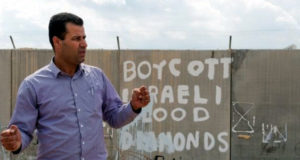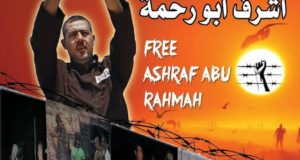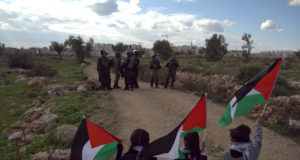by The Michigan Peace Team in Bil’in
Reflecting on one of our experiences in the Occupied Palestinian Territories:
On Friday June 30th our Summer 2006 Peace Team to Palestine/Israel participated in a large non-violent action in the Palestinian village of Bil’in. It was organized by Bil’in’s Popular Committee Against the Wall. Local Palestinians, Internationals, and Israeli peace activists joined in solidarity for this action. The goal of the action was to open the annexation barrier and reclaim Palestinian land.
The action included a march to the gate, songs, chanting, and communication regarding our goal. During the action, part of the group managed to get inside the gate and Palestinian flags were raised.
As we watched and learned from the Palestinians, three things stood out for us:
– The hope-filled determination of the Palestinians;
– Palestinian insistence that the group remain committed to non-violent word and action with the pledge to end the action if Israeli soldiers were harmed in any way; and,
– The discipline evident in the group.
Israeli soldiers, jeeps, and other armored vehicles were stationed at the gate and along the annexation barrier. The Israeli soldiers responded to the demonstration with force and violence. Repeatedly they launched sound bombs, tear gas and rubber bullets. While men, women, and children fled, this onslaught continued. Also Israeli shell casings for live ammunition were found after the action.
Two Israeli peace activists were arrested at the gate. One French citizen and three Palestinians were injured. Very early in the action a Palestinian man was shot in the eye with a rubber bullet. Some minutes later as we were fleeing, a sound bomb exploded two feet from a Michigan Peace Team member. She experienced difficulty in hearing. Thankfully, this condition began to diminish and after two hours and her hearing was restored.
As a follow-up to the demonstration, we all met for evaluation. To us as the Michigan Peace Team, the level of Israeli army violence was shocking, but we learned that local Palestinians had expected far worse. They stressed in no uncertain terms that the presence of the international and Israeli peace activists had definitely reduced the level of violence they normally experience as Palestinians.
On-going Palestinian work for peace with justice:
During the past year and a half, the response of Bil’in’s Popular Committee Against the Wall has been bold, creative, and consistently non-violent. Elements of their campaign include:
1. Organizing weekly demonstrations and actions.
2. Working in partnership with Israeli peace activists to take their case to the “world court of opinion” and to the Israeli Supreme Court where scholarly briefs and arguments have been submitted.
3. They succeeded in acquiring a court order which has temporarily halted settlement expansion.
4. The establishment of a Palestinian “outpost” directly in front of one Israeli settlement- constructed on Palestinian land belonging to the village of Bil’in. This outpost is staffed by Palestinians and internationals 24 hours a day seven days a week!
Some background on Bil’in:
Bil’in is a small farming village located near Ramallah in the West Bank . More than half of Bil’in’s farming acreage has been seized by the State of Israel for settlement development. The Bil’in community made the decision to resist non-violently and they have become a world-wide symbol of Palestinian non-violent resistance to the following policies of the State of Israel:
– theft of Palestinian land;
– construction of the annexation barrier;
– expansion of the Israeli settlements ; and,
– cementing of the Israeli occupation in the West Bank .
Illegality of the Israeli settlements:
In the global community, all nations and individuals are bound to uphold international law. Scholars and other members of the international legal community assert that the Israeli settlements are illegal under international law. This fact can be documented in scholarly briefs, as well as in popular publications:
“…the very existence of Israeli settlements is a direct violation of internationally binding agreements and regulations as international humanitarian law explicitly prohibits the occupying state to make permanent changes that are not, in the first place, intended to benefit the population of the occupied.” (Passia 2006)
Some background to the Supreme Court case:
By sharing some details important to Bil’in’s Supreme Court case we hope to shed some light on the interconnection between the annexation barrier, the role of the settlements, and Israeli occupation of the West Bank.
There is a 1998 Israeli master plan for the Occupied Palestinian Territories in the area of Bil’in Village. It sets a goal of 150,000 Israeli settlers in the area by the year 2020. This master plan is labeled “unofficial.” It ignores jurisdictional areas and calls for confiscation of Palestinian land. Significant steps have been underway to implement this master plan. Already a huge Israeli settlement on Palestine land overlooks Bil’in Village and other neighboring villages. It is called Upper Modi’in settlement and it extends as far as the eye can see.
Sub plans of the master plan have also been developed. In 1999, an Israeli urban plan entitled 210/8 was approved by a sub committee of the “Supreme Planning Council” of the Israeli military Civil Administration in the area known by the Israelis as “Judea and Samaria”, Biblical terminology for the West Bank often used by Zionists. Part of this plan calls for the construction of 1532 Israeli housing units on land confiscated from the Palestinian village of Bil’in. Now there is a more ambitious version called 210/8/1 which calls for 1,476 additional units, for a tota l of 3,008 settlement housing units in the area as part of the Upper Modi’in master plan.
The Israeli Supreme Court Case:
Construction of the 3,008 units on confiscated land got underway in 2004. On the Palestinian land owned by members of the Bil’in Village, an Israeli settlement known as Matityahu East is partially constructed. Not only are these buildings being constructed on occupied territory in violation of International Law, but they also lack valid Israeli building permits in violation of Israeli law. Settlement development paperwork amply documents this fact. For example, in March 2005, Gil’ad Rogel, the legal counsel for the orthodox Upper Modi’in settlement wrote to colleagues as well as the Planning Council that numerous construction violations against Israeli law were being carried out. It is this violation of Israeli law that the Israeli peace activists and residents of Bil’in are using to bring their case to the Israeli Supreme Court. By court order construction has been stopped in lieu of this Supreme Court case.
Interconnections…The annexation barrier, settlements, and Israeli occupation
There is ample evidence to suggest that settlement development plans gave birth to the annexation barrier and that the settlements cement the Israeli occupation of the West Bank. In a recent report entitled “Under the Guise of Security” Israeli organizations B’tselem and BIMKOM compared the Master Plan with the route of the annexation barrier. They write that, “The aerial photo of the Modi’in Illit bloc shows that the outline plan … was a primary consideration in setting the barrier’s route … In the eastern section the route follows the eastern borders of Plan 210/8/1. The state admits that these two plans were taken into account in setting the route.” The interconnection between the settlements and the occupation is equally as obvious. The settlements absorb large tracts of confiscated land; they require huge military presence to maintain their existence; and they exhaust/destroy local resources.
Information is taken from:
1. Research provided by the Ecumenical Accompaniment Programme In Palestine and Israel sponsored by the World Council of Churches in a publication entitled ChainReaction, Issue No.3.
2. The report entitled “Under the Guise of Security”
In conclusion, some key questions come to mind as we experience life here:
How can the State of Israel use “security concerns” to justify construction of the annexation barrier? The plans for settlement development were published before the second intifada began in the fall of 2000, and these plans clearly outline the route of the annexation barrier in this region of the West Bank.
What is the motivation of the State of Israel? Is it hatred of Palestinians or expansion and economic benefit at the expense of the occupied?
What are the national boundaries of the State of Israel?
How do we work together to raise awareness of these issues?
 International Solidarity Movement Nonviolence. Justice. Freedom.
International Solidarity Movement Nonviolence. Justice. Freedom.


